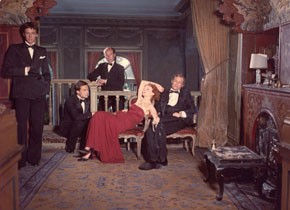To India!
Projections from Europe and America
December 4, 2013 to January 7, 2014
Since the dawn of cinema, Asia has been the favorite surface of Western filmmakers upon which to project their fantasies of the exotic "other". In this tradition, India always held a special place: on the one hand, it was obviously a high culture of long-standing, while on the other it was long subject to the will of a European power, the British Empire. It seems as if there was no place else on earth where the differences between cultures and classes were laid bare as unforgivingly as in India; but there was also no place else where one could as accurately observe how things can sometimes change – very slowly, blending together, becoming something new, and something extraordinary.
To India! presents approximately 25 films from the post-1947 period, when India gained independence. These works cover a wide range, from Rossellini’s and Pasolini's famous documentary essays of the 1950s and 60s, to one of the most engaging contemporary American “indies”, Chris Smith's The Pool (2007). From the visions of Fritz Lang, who realized his deepest German Orient(alist) dreams in the studio in 1959, to Marguerite Duras' no less "artificial" and erotic delirium of color, India Song (1975). Time and again, western filmmakers visited this country, to find or reinvent themselves, as did Louis Malle with his cinéma-vérité cacophony, Calcutta (1969) or Alain Corneau with India Nocturne (1989), his brilliant adaptation of Antonio Tabucchi’s novel. To both filmmakers, it was obvious that the sheer strangeness of the places and lives they would encounter in India would bring about intense self-examination.
Common to all these projections is that they willingly rush towards a shattering of the mirror – it seems that no one leaves India, either real or imagined, the way they arrived. Rare are the examples of a feeling of togetherness, as in James Ivory's Shakespeare-Wallah, which represented India at the 1965 Berlinale alongside Satyajit Ray's The Lonely Wife. Ivory's regular screenwriter was Ruth Prawer Jhabvala, born in Cologne (and deceased earlier this year). She spent the most important years of her life in India and was one of those literary boundary-crossers whose works served as the foundation for many of the key films in the series, including John Masters (Bhowani Junction) and Rumer Godden (Black Narcissus and The River). That Masters – long-accused of being an apologist for colonialism – created one of the most exact descriptions of the east-west Raj milieu is only one example of the complexity of circumstances that will be examined in this program.
This film series is based on Shanay Jhaveri’s book Outsider Films on India 1950-1990 (Shoestring Publishers, Mumbai, 2010) and on the eponymous program he curated for Tate Modern in 2010, as well as programs presented at the LUX/ICA Biennial of Moving Images and the Cultuurcentrum Brugge, both in 2012. The book will be available at the Film Museum box office.


